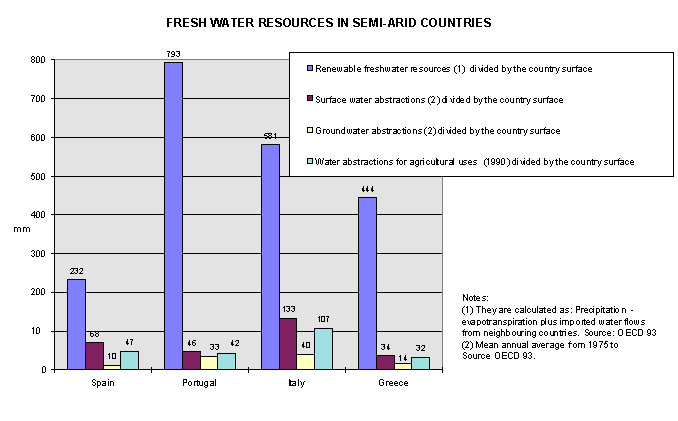3.
Current Water Resources Situation in Semi-Arid Zones of the EEA
3.1. Introduction
Meeting demands (as regards quantity
and quality) is one of the main aims of water resource planning and management. To find an
equilibrium between human activities and needs, and the availability in particular areas
is a key issue in semi-arid regions. As a consequence of an unsustainable development
model, particularly agricultural, demands are often greater than the available resources.
Many of the water resource problems existing in the EEA semi-arid zones may be solved by
looking for a more "realistic" agreement between demands and exploitation.
The agricultural sector consumes an
extremely high percentage of water resources in these zones (see Figure 3.1-1),
particularly when quantified as the relationship between the water abstracted for
agricultural uses and the country surface area). Most crops only require water for a
limited number of months, but these do not coincide with the seasonal distribution of
precipitation and runoff. The natural water supply ceases in summer and autumn, and this
has a negative effect on crops, which means that water courses have to be controlled by
the construction of reservoirs.

Figure -1 Freshwater resources
and abstractions in semi-arid countries
The differences in yield from year
to year, makes it necessary to construct large dams for the purpose of water storage in
wet years, so that demands can be met in dry years. Sedimentation or eutrophication are
common problems in many of those reservoirs. There are other problems associated to them,
such as the reduction of the biodiversity downstream and the interruption of fish
migration. The establishment of a common policy for ecological and minima flows to be
guaranteed by reservoir management is a key question in order to maintain the aquatic
biodiversity.
The conjunctive use of surface water
and groundwater is a main factor in order to meet demands in semi-arid zones. However,
excessive use of the aquifers can cause over-exploitation problems with the consequent
negative environmental, social and economic impact. In coastal areas, excessive water
extraction causes the water table to drop, giving rise to the sea water intrusion
phenomenon. To consider any options which help save water must be one of the first steps
in water management in semi-arid areas. The use of technologies that improve efficiency
(e.g. drip irrigation in agriculture) is an example of saving water. Another possibility
involves carrying out research into new crop varieties with lower water requirements being
temporally coincident with the wet season. These new crops should be consistent with the
European Joint Agricultural Policy, that hopefully will allocate each type of crop to the
appropriate type of climate (INAG, 1995a). Sometimes, however neither the saving measures
nor suitable management of water resources of the basins are sufficient. It would be
necessary to transfer water from basins with a surplus to those with a deficit by means of
works such as aqueducts.
In urban areas, the main problems
concern water supply, wastewater treatment and flood prevention. The water supply can be
guaranteed by storage in reservoirs, or by pumping groundwater when possible. Wastewater
must be treated before being returned to a river whose discharge is very low either all
year round or during the dry season. Once it has been treated it can be used to recharge
aquifers, by percolation from shallow pools or injection wells, but such practice is not
common in semi-arid areas. After being properly treated, wastewater can also be used for
irrigation purposes, a practice which has been used recently in Greece. Floods bring about
a high element of risk, especially in the case of steeply sloping basins, because of the
high velocity that the water reaches. The transport of considerable amounts of sediment is
an additional danger. The strategy for dealing with floods is based on the application of
structural measures (reservoir construction, channelling, dikes, etc.) and non-structural
measures, (flood warning systems, management of flood areas, etc.). Erosion and soil loss
in the basins, is another problem closely associated with the flood phenomenon. This
problem is remarkable in the Mediterranean zones, which are periodically affected by
forest fires that accelerate the erosion process as a consequence of the loss of vegetable
cover. The reduction of water resources coupled with the erosion problem, can lead to
desertification in many areas inside the semi-arid regions, with the consequent
socio-economic repercussions.
A greater in-depth review of some of
the problems mentioned above is described in the following sections.


Document Actions
Share with others